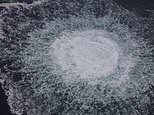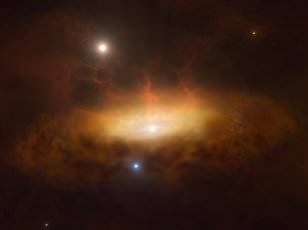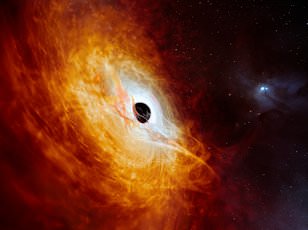Huge black hole 8,200 times the size of the Sun is discovered in a neighbouring star cluster - and scientists say it's the 'missing link' in the formation of these mysterious voids
- Researchers have discovered a massive black hole just 18,000 light years away
- This 'intermediate' object could be the missing link in black holes' evolution
As much as we learn about the mysteries of black holes, many questions remain about these enigmatic objects.
Now, scientists have discovered a vast black hole more than 8,200 times the mass of ours sun in a nearby star cluster which could unravel these voids' secrets.
Located at the heart of the Omega Centauri cluster 18,000 light years away, this super-dense object is the closest example of a massive black hole ever discovered.
Although it may seem vast, researchers from the Max Planck Institute for Astronomy and the University of Utah, say this is just a middle-sized black hole.
Researchers say this first-of-its-kind discovery could provide the 'missing link' in the mysterious evolution of black holes.
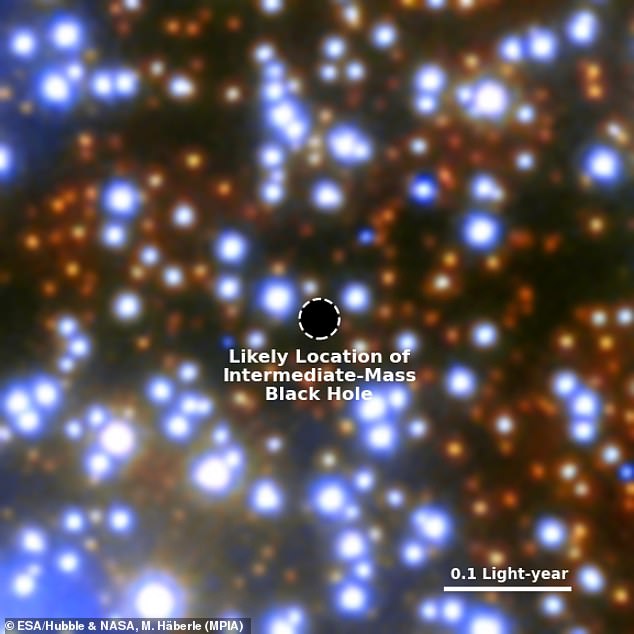
Scientists have discovered a massive black hole just 18,000 light years from Earth which could be the missing link the evolution of these strange objects
Black holes are formed when extremely large stars collapse in on themselves as they expend the last of their fuel.
As the stars fall inwards, their remaining mass becomes compressed into an object so dense that not even light can escape its gravitational pull.
These objects range in size from 'stellar black holes' only a few times the mass of our sun to truly vast monsters called 'supermassive black holes' with millions or billions of stellar masses.
Co-author Matthew Whittaker, a undergraduate student at the university of Utah, says: 'There are black holes a little heavier than our sun that are like ants or spiders—they’re hard to spot, but kind of everywhere throughout the universe.
'Then you've got supermassive black holes that are like Godzilla in the centers of galaxies tearing things up, and we can see them easily.'
However, so-called 'intermediate black holes' are extremely difficult to observe since galaxies tend to only have massive black holes at their centre.
Mr Whittaker says: 'These intermediate-mass black holes are kind of on the level of Bigfoot. Spotting them is like finding the first evidence for Bigfoot—people are going to freak out.'
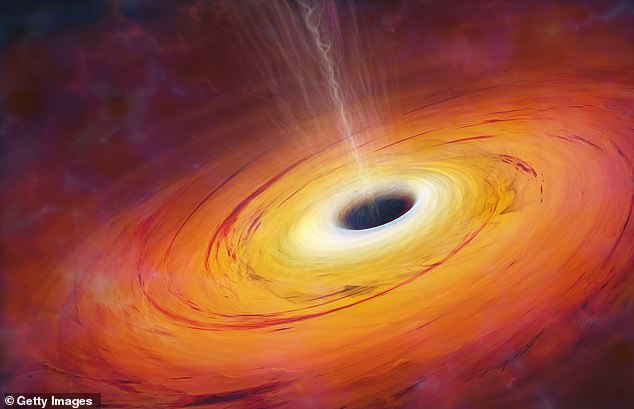
Black holes form when huge stars collapse into dense objects which pull in everything around them. As they 'feed' on surrounding matter, some grow into supermassive black holes like the one at the centre of the Milky Way
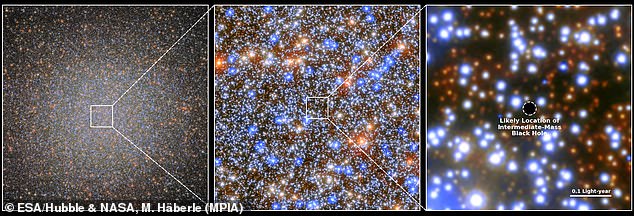
Researchers believe that the Omega Centauri cluster (pictured left) was once a galaxy of its own that was swallowed by the Milky Way. This makes it likely that there is a black hole (illustrated right) at its centre
Luckily, the Omega Centauri cluster's unique history gave researchers a perfect opportunity to find one of these rare objects.
Scientists believe that Omega Centauri was once a galaxy of its own that was swallowed up by the Milky Way billions of years ago.
Stripped of its outer stars, the dense core of stars that we can see through our telescopes is all that remains of what once made up the galactic nucleus.
That made it extremely likely that there was a young black hole trapped at the heart of Omega Centauri, frozen in time like a bug in amber.
Unable to feed on surrounding stars, scientists predicted that the intermediate black hole should still be just as it was when the Milky Way first swallowed it.
To test this theory, researchers examined 500 images taken by the Hubble Space Telescope.
Although most of these pictures were simply taken to calibrate Hubble's instruments, they still allowed researchers to track the speed of 1.4 million stars.
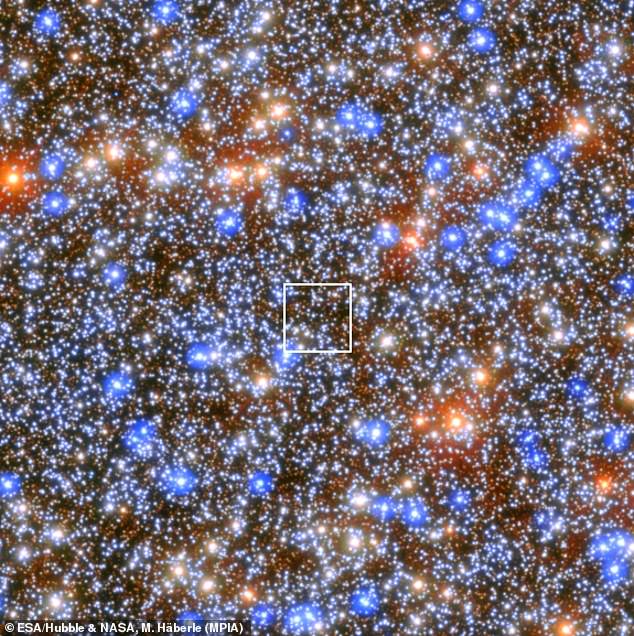
Using observations from the Hubble Space Telescope such as this one, researchers identified seven high-speed stars which are being pulled by a black hole at least 8,200 times the mass of our sun
Out of that 1.4 million, scientists found seven stars right near the centre which were moving at unexpectedly high speeds.
Dr Maximilian Häberle, of the Max Planck Institute of Astronomy, says: 'Looking for high-speed stars and documenting their motion was the proverbial search for a needle in a haystack.'
Just one fast-moving star wouldn't have proven anything as the star's rapid transit could have been caused by any number of different factors.
However, the presence of seven stars moving quickly in the same region is strong evidence that they are being dragged by the gravity of an extremely dense object.
By pinpointing the speed of those seven high-speed stars, Dr Häberle and his co-authors were able to work out the likely mass and location of that hidden object.
As they had predicted, at at least 8,200 solar masses, this object was likely to be an example of the long-sought-after intermediate black hole.
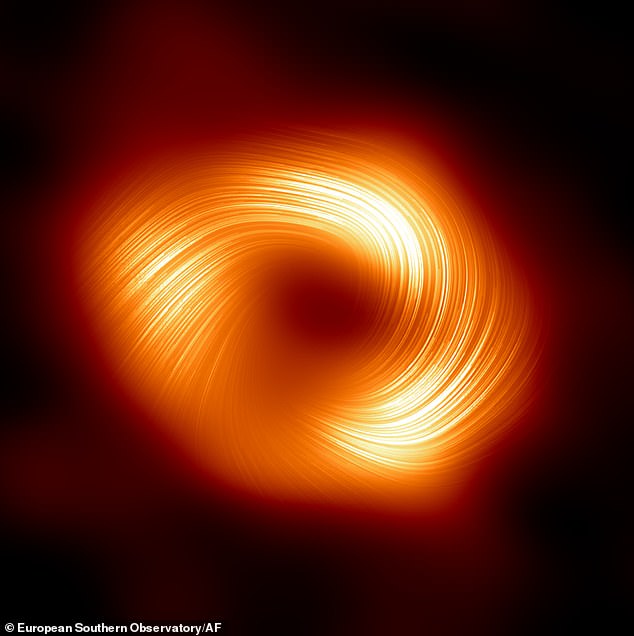
This discovery could help explain how black holes like the one at the centre of our galaxy (pictured) come to be so large
Co-author Dr Nadine Neumayer, also from the Max Planck Institute of Astronomy, says: 'Previous studies had prompted critical questions of "So where are the high-speed stars?"
'We now have an answer to that and the confirmation that Omega Centauri contains an intermediate-mass black hole.'
The researchers now plan to study the centre of Omega Centauri in greater detail and have already secured permission to use NASA's James Webb Space Telescope.
However, due to the lower mass of this black hole, it may take hundreds of years for the high-speed stars to complete a single orbit.
That means that making a complete study of this black hole could remain a task for future generations.

























